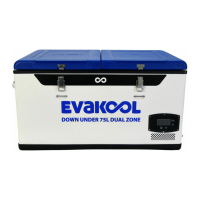DOWN UNDER SERIES
15
What is Climate Class?
Refrigerators are designed to work under certain climate conditions which are rated by
climate classes. It indicates the minimum and maximum temperature limits, within which
the refrigerators are able to operate properly.
All fridges and freezers are rated with 4 main climate classes as below:
1. SN (Subnormal) suitable for use under ambient temperature range of 10°C-32°C.
2. N (Normal) suitable for use under ambient temperature range of 16°C-32°C.
3. ST (Subtropical) suitable for use under ambient temperature range of 18°C-38°C.
4. SN (Tropical) suitable for use under ambient temperature range of 18°C-43°C.
Note: These abbreviations are conventional because they are regulated by international
standards (IEC Clauses) and do not depend on a maker or a country of production.
Some fridges and freezers are developed with combined climate classes to allow the
operation within a wider temperature range, like some outdoor locations or special
regions. For example:
1. N - ST suitable to operate under temperatures ranging from 16°C - 38°C (61°F-100°F).
2. SN - T suitable to operate under temperatures ranging from 10°C - 43°C (50°F-109°F).
Why is it so important to choose a fridge with appropriate Climate Class?
Not all refrigerating appliances are suitable for all ambient temperature ranges. Very few
people would check or even know about the characteristics of climate classes, but it is
really important to think twice before the purchase. Here are some reasons:
• If a fridge keeps running under the climate conditions that it is not intended for, it will
consume much more energy to reach the required inside temperature.
• The fridge will not cool the inside product suiciently, which will lead to excessive
condensation.
• The viscosity of the oil in the compressor will increase if it works at ambient temperature
under 10°C (50°F), and with the loss of fluidity, the compressor could be damaged easily.
• The lifespan of the refrigerators will decrease significantly.

